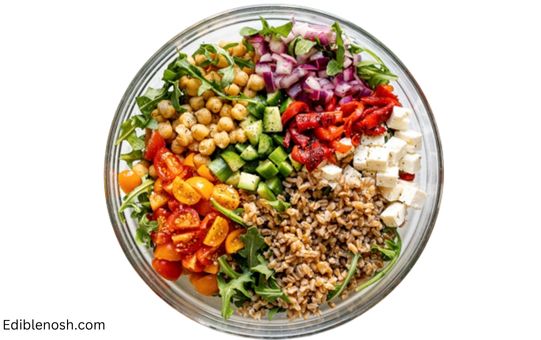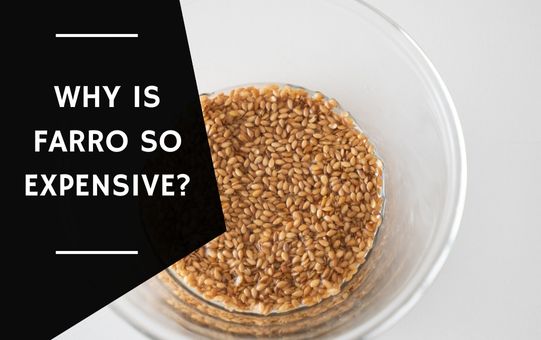If you’ve ever purchased farro, you may have noticed that it is typically more expensive than rice or quinoa. However, why is farro so expensive?
Farro is an ancient wheat variety that is more expensive than other grains due to its limited cultivation, labor-intensive production method, and rising demand. Its distinctive flavor and nutritional benefits justify the higher price for many individuals.
In this article, we will investigate the unique properties of farro and the reasons for its high price.
Contents
What Is Farro?
Farro is an ancient grain that has been cultivated for thousands of years. It is believed to have originated in the Fertile Crescent, a region in the Middle East that encompasses parts of modern-day Iraq, Syria, Lebanon, Israel, and Palestine.
Farro is a type of wheat, and it is often referred to as “spelt” or “emmer wheat.” It is a staple in many traditional cuisines, including Italian, Egyptian, and Turkish.
Unlike modern wheat, farro is an heirloom variety that has not been genetically modified or hybridized. This means that it is more akin to the wheat that our ancestors ate, and it retains many of the nutritional properties of ancient grains. Farro is high in fiber, protein, and minerals like iron and zinc. It also has a nutty, slightly sweet flavor that makes it a popular choice in both sweet and savory dishes.
Read Also: Can I Substitute Farro For Pearl Barley?
Why Is Farro More Expensive Than Other Grains?
There are a few reasons why farro tends to be more expensive than other grains. One of the main reasons is that farro is not as widely cultivated as other grains like rice or wheat. Farro is grown in only a few parts of the world, and it requires specific growing conditions to thrive. This means that farro is not as easily available as other grains, and the supply is limited.
Another reason for the higher cost of farro is the labor-intensive process of harvesting and processing the grain. Farro is typically harvested by hand, which adds to the cost of production. In addition, farro must be milled and cleaned carefully to preserve the integrity of the grain. This adds to the cost of the final product.
Another factor that contributes to the price of farro is the demand for grain. Farro has gained popularity in recent years as more people have become interested in ancient grains and the health benefits they offer. This increased demand has led to a higher price for farro, as the supply cannot keep up with the demand.

Is Farro Worth the Extra Cost?
While farro is more expensive than other grains, many people believe that it is worth the extra cost due to its unique flavor and nutritional profile.
Farro is a good source of fiber, which can help support digestion and maintain healthy blood sugar levels. It is also a good source of protein, making it a good choice for vegetarians and vegans looking to add protein to their diet.
In addition to its nutritional benefits, farro has a distinctive, nutty flavor that makes it a great addition to a variety of dishes. It can be used in place of rice in grain bowls, salads, and pilafs, or as a base for soups and stews. It can also be used in sweet dishes like porridge and baked goods.
How to Use Farro?
Farro is a versatile grain that can be used in a variety of dishes. It has a chewy texture and a nutty flavor that pairs well with a range of ingredients. Here are a few ideas for using farro in your cooking:
- Add farro to grain bowls with roasted vegetables, protein, and a flavorful dressing.
- Combine farro with beans and vegetables for a hearty soup or stew.
- Use farro in place of rice in pilafs and salads.
- Use farro in place of pasta in dishes like farro risotto or farro pasta salad.
- Cook farro with milk and honey for a warm, nourishing breakfast porridge.
- Use farro flour in place of all-purpose flour in baked goods like bread, cookies, and cakes.
It’s important to note that farro should be soaked in water for at least 30 minutes (and up to 8 hours) before cooking to help soften the grain and reduce the cooking time. Farro can be cooked in boiling water or broth on the stovetop, or it can be cooked in a rice cooker or pressure cooker.
Read Also: Can I Substitute Orzo for Farro?
Conclusion
Farro is an ancient grain that is more expensive than other grains due to its limited cultivation, labor-intensive production process, and increasing demand.
While it may come with a higher price tag, many people believe that farro is worth the extra cost due to its unique flavor and nutritional benefits. Farro is a versatile grain that can be used in a variety of dishes and can be a great addition to a healthy diet.
FAQs | Why is Farro so expensive?
Following are the five most relevant questions why is farro so expensive?:
What Is Farro And Where Does It Come From?
Farro is an ancient grain that has been cultivated for thousands of years. It is believed to have originated in the Fertile Crescent, a region in the Middle East that encompasses parts of modern-day Iraq, Syria, Lebanon, Israel, and Palestine.
Farro is a type of wheat, and it is often referred to as “spelt” or “emmer wheat.”
Why Is Farro More Expensive Than Other Grains?
There are a few reasons why farro tends to be more expensive than other grains. One of the main reasons is that farro is not as widely cultivated as other grains like rice or wheat.
Farro is grown in only a few parts of the world, and it requires specific growing conditions to thrive. This means that farro is not as easily available as other grains, and the supply is limited.
Is Farro Worth The Extra Cost?
While farro is more expensive than other grains, many people believe that it is worth the extra cost due to its unique flavor and nutritional profile.
Farro is a good source of fiber, which can help support digestion and maintain healthy blood sugar levels. It is also a good source of protein, making it a good choice for vegetarians and vegans looking to add protein to their diet.
How Is Farro Used In Cooking?
Farro is a versatile grain that can be used in a variety of dishes. It has a chewy texture and a nutty flavor that pairs well with a range of ingredients.
Farro can be used in place of rice in grain bowls, salads, and pilafs, or as a base for soups and stews. It can also be used in sweet dishes like porridge and baked goods.
How Should Farro Be Prepared Before Cooking?
It’s important to soak farro in water for at least 30 minutes (and up to 8 hours) before cooking to help soften the grain and reduce the cooking time.
Farro can be cooked in boiling water or broth on the stovetop, or it can be cooked in a rice cooker or pressure cooker.

